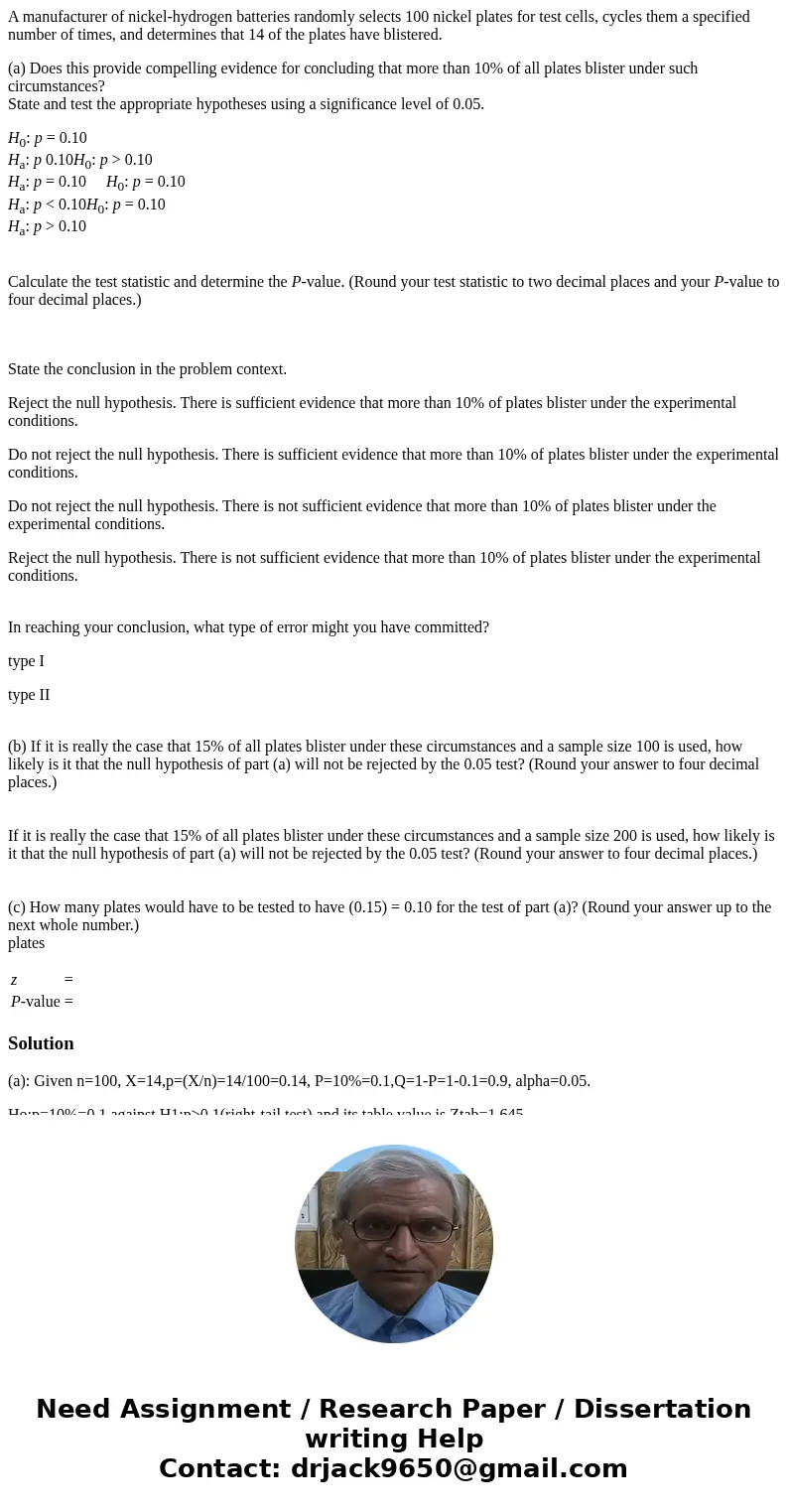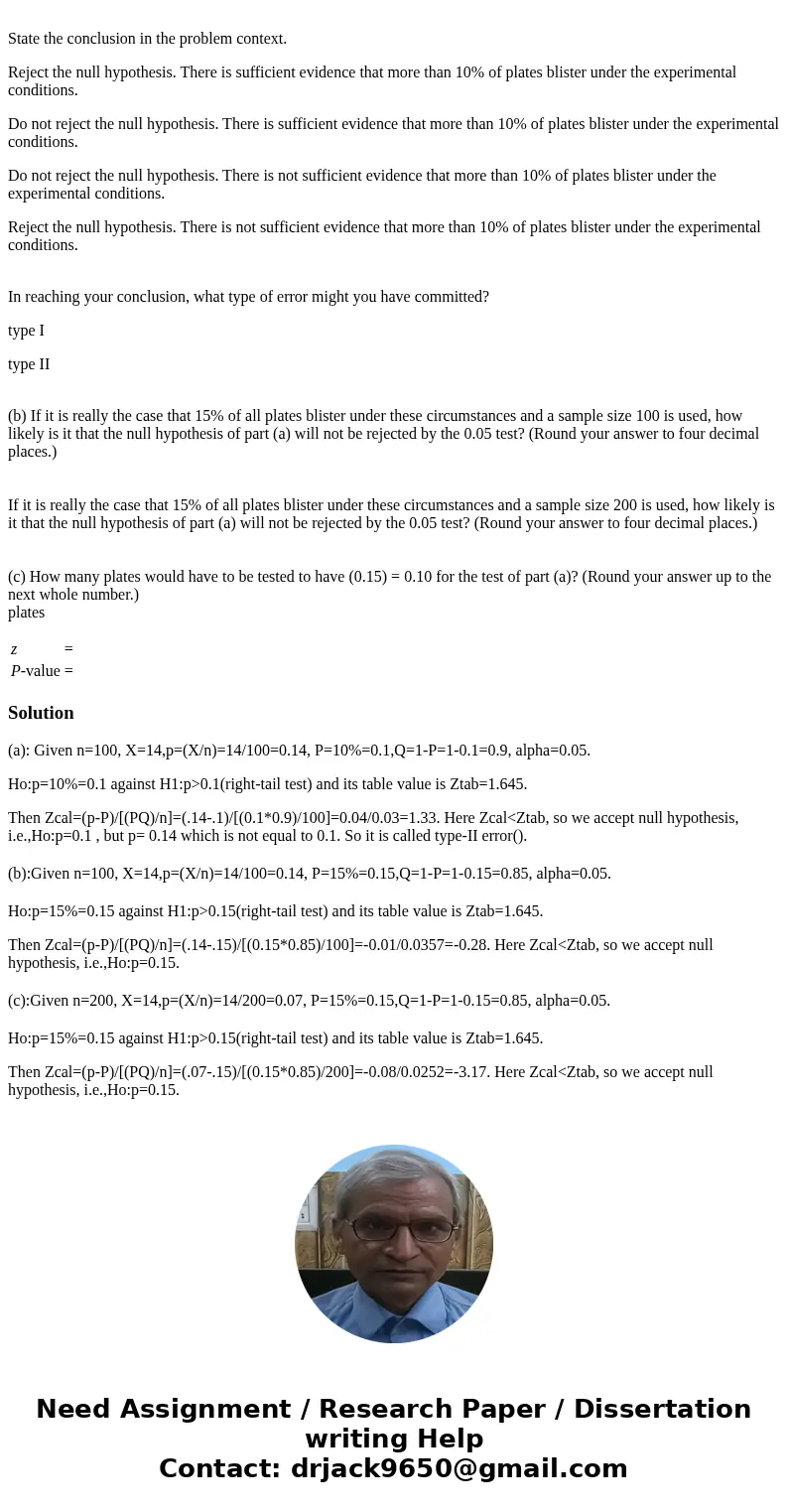A manufacturer of nickelhydrogen batteries randomly selects
A manufacturer of nickel-hydrogen batteries randomly selects 100 nickel plates for test cells, cycles them a specified number of times, and determines that 14 of the plates have blistered.
(a) Does this provide compelling evidence for concluding that more than 10% of all plates blister under such circumstances?
State and test the appropriate hypotheses using a significance level of 0.05.
H0: p = 0.10
Ha: p 0.10H0: p > 0.10
Ha: p = 0.10 H0: p = 0.10
Ha: p < 0.10H0: p = 0.10
Ha: p > 0.10
Calculate the test statistic and determine the P-value. (Round your test statistic to two decimal places and your P-value to four decimal places.)
State the conclusion in the problem context.
Reject the null hypothesis. There is sufficient evidence that more than 10% of plates blister under the experimental conditions.
Do not reject the null hypothesis. There is sufficient evidence that more than 10% of plates blister under the experimental conditions.
Do not reject the null hypothesis. There is not sufficient evidence that more than 10% of plates blister under the experimental conditions.
Reject the null hypothesis. There is not sufficient evidence that more than 10% of plates blister under the experimental conditions.
In reaching your conclusion, what type of error might you have committed?
type I
type II
(b) If it is really the case that 15% of all plates blister under these circumstances and a sample size 100 is used, how likely is it that the null hypothesis of part (a) will not be rejected by the 0.05 test? (Round your answer to four decimal places.)
If it is really the case that 15% of all plates blister under these circumstances and a sample size 200 is used, how likely is it that the null hypothesis of part (a) will not be rejected by the 0.05 test? (Round your answer to four decimal places.)
(c) How many plates would have to be tested to have (0.15) = 0.10 for the test of part (a)? (Round your answer up to the next whole number.)
plates
| z | = | |
| P-value | = |
Solution
(a): Given n=100, X=14,p=(X/n)=14/100=0.14, P=10%=0.1,Q=1-P=1-0.1=0.9, alpha=0.05.
Ho:p=10%=0.1 against H1:p>0.1(right-tail test) and its table value is Ztab=1.645.
Then Zcal=(p-P)/[(PQ)/n]=(.14-.1)/[(0.1*0.9)/100]=0.04/0.03=1.33. Here Zcal<Ztab, so we accept null hypothesis, i.e.,Ho:p=0.1 , but p= 0.14 which is not equal to 0.1. So it is called type-II error().
(b):Given n=100, X=14,p=(X/n)=14/100=0.14, P=15%=0.15,Q=1-P=1-0.15=0.85, alpha=0.05.
Ho:p=15%=0.15 against H1:p>0.15(right-tail test) and its table value is Ztab=1.645.
Then Zcal=(p-P)/[(PQ)/n]=(.14-.15)/[(0.15*0.85)/100]=-0.01/0.0357=-0.28. Here Zcal<Ztab, so we accept null hypothesis, i.e.,Ho:p=0.15.
(c):Given n=200, X=14,p=(X/n)=14/200=0.07, P=15%=0.15,Q=1-P=1-0.15=0.85, alpha=0.05.
Ho:p=15%=0.15 against H1:p>0.15(right-tail test) and its table value is Ztab=1.645.
Then Zcal=(p-P)/[(PQ)/n]=(.07-.15)/[(0.15*0.85)/200]=-0.08/0.0252=-3.17. Here Zcal<Ztab, so we accept null hypothesis, i.e.,Ho:p=0.15.


 Homework Sourse
Homework Sourse